Monotropastrum kirishimense (Ericaceae), a new mycoheterotrophic plant from Japan based on multifaceted evidence
- PMID: 36445504
- PMCID: PMC9832082
- DOI: 10.1007/s10265-022-01422-8
Monotropastrum kirishimense (Ericaceae), a new mycoheterotrophic plant from Japan based on multifaceted evidence
Abstract
Due to their reduced morphology, non-photosynthetic plants have been one of the most challenging groups to delimit to species level. The mycoheterotrophic genus Monotropastrum, with the monotypic species M. humile, has been a particularly taxonomically challenging group, owing to its highly reduced vegetative and root morphology. Using integrative species delimitation, we have focused on Japanese Monotropastrum, with a special focus on an unknown taxon with rosy pink petals and sepals. We investigated its flowering phenology, morphology, molecular identity, and associated fungi. Detailed morphological investigation has indicated that it can be distinguished from M. humile by its rosy pink tepals and sepals that are generally more numerous, elliptic, and constantly appressed to the petals throughout its flowering period, and by its obscure root balls that are unified with the surrounding soil, with root tips that hardly protrude. Based on genome-wide single-nucleotide polymorphisms, molecular data has provided clear genetic differentiation between this unknown taxon and M. humile. Monotropastrum humile and this taxon are associated with different Russula lineages, even when they are sympatric. Based on this multifaceted evidence, we describe this unknown taxon as the new species M. kirishimense. Assortative mating resulting from phenological differences has likely contributed to the persistent sympatry between these two species, with distinct mycorrhizal specificity.
Keywords: Fungal association; Integrative taxonomy; Mycoheterotrophy; Mycorrhizas; Reproductive isolation; SNP data; Speciation; Species delimitation.
© 2022. The Author(s).
Conflict of interest statement
The authors declare no conflict of interest.
Figures


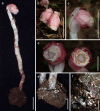
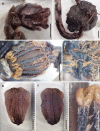
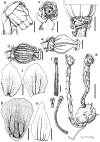

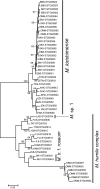

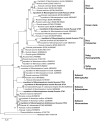
Similar articles
-
Exploring mycorrhizal diversity in sympatric mycoheterotrophic plants: a comparative study of Monotropastrum humile var. humile and M. humile var. glaberrimum.Mycorrhiza. 2024 Jul;34(4):283-292. doi: 10.1007/s00572-024-01158-4. Epub 2024 Jun 25. Mycorrhiza. 2024. PMID: 38918244
-
Mycorrhizal fungi associated with Monotropastrum humile (Ericaceae) in central Japan.Mycorrhiza. 2011 Aug;21(6):569-576. doi: 10.1007/s00572-011-0365-3. Epub 2011 Feb 19. Mycorrhiza. 2011. PMID: 21336506
-
Molecular identification of the mycorrhizal fungi of the epiparasitic plant Monotropastrum humile var. glaberrimum (Ericaceae).J Plant Res. 2005 Feb;118(1):53-6. doi: 10.1007/s10265-004-0188-9. Epub 2005 Jan 14. J Plant Res. 2005. PMID: 15650809
-
Taxonomic status of Monotropastrum humile, with special reference to M. humile var. glaberrimum (Ericaceae, Monotropoideae).J Plant Res. 2008 May;121(3):271-8. doi: 10.1007/s10265-008-0157-9. Epub 2008 Apr 4. J Plant Res. 2008. PMID: 18389172
-
Model systems to unravel the molecular mechanisms of heavy metal tolerance in the ericoid mycorrhizal symbiosis.Mycorrhiza. 2016 May;26(4):263-74. doi: 10.1007/s00572-015-0675-y. Epub 2015 Dec 28. Mycorrhiza. 2016. PMID: 26710764 Review.
Cited by
-
Habitat-related plastome evolution in the mycoheterotrophic Neottia listeroides complex (Orchidaceae, Neottieae).BMC Plant Biol. 2023 May 27;23(1):282. doi: 10.1186/s12870-023-04302-y. BMC Plant Biol. 2023. PMID: 37244988 Free PMC article.
-
Exploring mycorrhizal diversity in sympatric mycoheterotrophic plants: a comparative study of Monotropastrum humile var. humile and M. humile var. glaberrimum.Mycorrhiza. 2024 Jul;34(4):283-292. doi: 10.1007/s00572-024-01158-4. Epub 2024 Jun 25. Mycorrhiza. 2024. PMID: 38918244
-
High mycorrhizal specificity in the monotypic mycoheterotrophic genus Relictithismia (Thismiaceae).Mycorrhiza. 2025 Apr 10;35(2):29. doi: 10.1007/s00572-025-01202-x. Mycorrhiza. 2025. PMID: 40208340
-
Spiranthes hachijoensis (Orchidaceae), a new species within the S. sinensis species complex in Japan, based on morphological, phylogenetic, and ecological evidence.J Plant Res. 2023 May;136(3):333-348. doi: 10.1007/s10265-023-01448-6. Epub 2023 Mar 17. J Plant Res. 2023. PMID: 36930386 Free PMC article.
-
Why Does Non-Photosynthetic Monotropastrum humile (Ericaceae) Have Scale Leaves?Plant Environ Interact. 2025 Jun 4;6(3):e70060. doi: 10.1002/pei3.70060. eCollection 2025 Jun. Plant Environ Interact. 2025. PMID: 40470376 Free PMC article.
References
-
- Andres H. Über die Pirolaceen-Gattung Monotropastrum. H Andr Notizbl Bot Gaz. 1935;12:696–699.
-
- Andres H. Pirolaceae. Symbolae Sinicae: Anthophyta. 1936;7:762–768.
MeSH terms
Grants and funding
LinkOut - more resources
Full Text Sources

